当前位置:网站首页>Overview of Fourier analysis
Overview of Fourier analysis
2022-07-05 22:37:00 【Xiao Qiu HUST】
Fourier transform is mainly divided into two parts: continuous and discrete . Analysis of continuous time signals , From the Fourier series of periodic signals (FS) Expand to the unified Fourier transform (FT), It is a complete system . Fourier analysis of discrete-time signals is very similar to that of continuous time signals , But it's really different , There is no unified expression , The main difference is “ Sum up ” and “ integral ” On .FS,FT,DFS,DTFT,DFT It forms the whole system of Fourier analysis .
No matter what kind of transformation , All satisfied with “ cycle - discrete ”,“ Aperiodic - continuity ” Correspondence of . This relationship is very useful for helping memory .
| Analysis method | abbreviation | The transformation process Time domain signal → Frequency domain signal |
|---|---|---|
| Fourier series | FS | Continuous period → Aperiodic discrete |
| The Fourier transform | FT | ( introduce δ ( ω ) \delta(\omega) δ(ω)) Continuous period → Aperiodic discrete Continuous aperiodic → Aperiodic continuous |
| Discrete Fourier series | DFS | Discrete period → Periodic discretization |
| Discrete time Fourier transform | DTFT | Discrete aperiodic → Periodic continuity |
| Discrete Fourier transform | DFT | Discrete aperiodic → Discrete aperiodic ( The essence ) Discrete period → Periodic discretization |
Continuous time Fourier analysis
Fourier series
Continuous time analysis starts with Fourier series .
f ( t ) = f ( t + T 0 ) f ( t ) = ∑ n = − ∞ + ∞ a n e − j n ω 0 f(t) = f(t + {T_0})\;\;\;\;\;f(t) = \sum\limits_{n = - \infty }^{ + \infty } { {a_n}{e^{ - jn{\omega _0}}}} f(t)=f(t+T0)f(t)=n=−∞∑+∞ane−jnω0
Any period is T 0 T_0 T0( The frequency is f 0 f_0 f0, Angular frequency is ω 0 \omega_0 ω0) The periodic signal of , Can use angular frequency ω 0 \omega_0 ω0 Integer multiple complex exponential signal e − j n ω 0 e^{ - jn{\omega _0}} e−jnω0 Linear representation .
Such as cosine signal A c o s ( ω 0 t ) Acos(\omega_0t) Acos(ω0t) Fourier series expansion can be expressed as :
A c o s ( ω 0 t ) = A 2 ( e − j ω 0 t + e j ω 0 t ) Acos(\omega_0t)={A \over 2}\left( { {e^{ - j{\omega_0}t}} + {e^{j{\omega_0}t}}} \right) Acos(ω0t)=2A(e−jω0t+ejω0t)

The amplitude spectrum obtained by Fourier transform of real signal is always even symmetric , The phase spectrum is always odd symmetric . A cosine signal can be decomposed into two conjugate complex exponential signals , As shown in the figure below .
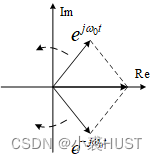
Over time t t t An increase in , They rotate constantly on the complex plane , But their vector sum always falls on the real axis , External performance is a real signal .
That's why “ Negative frequency ” The reason for its existence , there “ negative ” It means that the angular frequency of the complex exponential signal is negative , And “ Positive frequency ” The signal of is conjugate . Complex exponential signals that are conjugate with each other form a real signal .
The Fourier transform
Fourier series is limited to the analysis of periodic signals , For aperiodic signals , The period of the signal can be regarded as infinity , Based on this idea , It can be extended from the analytical synthesis formula of Fourier series to Fourier transform pair . The following is the analytical synthesis formula of Fourier series :
a n = 1 T 0 ∫ T 0 f ( t ) e − j n ω 0 t d t f ( t ) = ∑ n = − ∞ + ∞ a n e j n ω 0 {a_n} = {1 \over { {T_0}}}\int\limits_{ {T_0}} {f(t){e^{ - jn{\omega _0}t}}dt} \;\;\;\;f(t) = \sum\limits_{n = - \infty }^{ + \infty } { {a_n}{e^{jn{\omega _0}}}} an=T01T0∫f(t)e−jnω0tdtf(t)=n=−∞∑+∞anejnω0
a n a_n an Represents the Fourier series with the fundamental wave n n n Coefficient of complex exponential signal of subharmonic relationship . Write them together to get :
f ( t ) = ∑ n = − ∞ + ∞ ( 1 T 0 ∫ T 0 f ( t ) e − j n ω 0 t d t ) e j n ω 0 f(t) = \sum\limits_{n = - \infty }^{ + \infty } {\left( { {1 \over { {T_0}}}\int\limits_{ {T_0}} {f(t){e^{ - jn{\omega _0}t}}dt} } \right){e^{jn{\omega _0}}}} \; f(t)=n=−∞∑+∞⎝⎛T01T0∫f(t)e−jnω0tdt⎠⎞ejnω0
= ∫ − ∞ + ∞ ( ∫ − ∞ + ∞ f ( t ) e − j n ω 0 t d t ) e j n ω 0 d f = \int_{ - \infty }^{ + \infty } {\left( {\int_{ - \infty }^{ + \infty } {f(t){e^{ - jn{\omega _0}t}}dt} } \right){e^{jn{\omega _0}}}df} =∫−∞+∞(∫−∞+∞f(t)e−jnω0tdt)ejnω0df
When T 0 T_0 T0 Towards infinity , f 0 f_0 f0 Tends to infinity , The original sum needs to be changed to integral , The differential variable is from the original 1 / T 0 1/T_0 1/T0 Transformed d f df df.
= 1 2 π ∫ − ∞ + ∞ ( ∫ − ∞ + ∞ f ( t ) e − j n ω 0 t d t ) e j n ω 0 d ω = {1 \over {2\pi }}\int_{ - \infty }^{ + \infty } {\left( {\int_{ - \infty }^{ + \infty } {f(t){e^{ - jn{\omega _0}t}}dt} } \right){e^{jn{\omega _0}}}d\omega } =2π1∫−∞+∞(∫−∞+∞f(t)e−jnω0tdt)ejnω0dω
d f df df To d ω d\omega dω It needs to be multiplied by 2 π 2\pi 2π, So there is one in the synthesis of the last Fourier transform 1 / 2 π 1/2\pi 1/2π The coefficient of .
X ( j ω ) = ∫ − ∞ + ∞ f ( t ) e − j ω t d t f ( t ) = 1 2 π ∫ − ∞ + ∞ X ( j ω ) e j ω t d ω X(j\omega ) = \int_{ - \infty }^{ + \infty } {f(t){e^{ - j\omega t}}dt} \;\;\;\;\;\;f(t) = {1 \over {2\pi }}\int_{ - \infty }^{ + \infty } {X(j\omega ){e^{j\omega t}}d\omega } X(jω)=∫−∞+∞f(t)e−jωtdtf(t)=2π1∫−∞+∞X(jω)ejωtdω
Unity of periodic and aperiodic signals
After introducing the impulse signal δ ( t ) \delta(t) δ(t) after , The Fourier transform of periodic signal and aperiodic signal is unified . The problem of Fourier transform of periodic signals is that the analytical formula of Fourier transform is an integral in infinite range , Periodic signals cannot converge when doing such integrals .
Periodic signals can be decomposed into the sum of multiple complex exponential signals . So as long as we can express the Fourier transform of complex exponential signal, we can get the Fourier transform of periodic signal . Combined with the frequency shift property of Fourier transform :
e j ω 0 t x ( t ) ⇔ X ( j ( ω − ω 0 ) ) {e^{j{\omega _0}t}}x(t) \Leftrightarrow X\left( {j\left( {\omega - {\omega _0}} \right)} \right) ejω0tx(t)⇔X(j(ω−ω0))
We just need to know "1" The Fourier transform of the complex exponential signal can be obtained by the Fourier transform of . The specific solution process has been written , article A relatively complete derivation process is given in , I won't go into details here , The result is the following :
1 ⇔ 2 π δ ( ω ) 1 \Leftrightarrow 2\pi \delta \left( \omega \right) 1⇔2πδ(ω)
This result is also quite natural , hold 2 π δ ( ω ) 2\pi \delta \left( \omega \right) 2πδ(ω) It is obvious that it can be established by substituting it into the Fourier transform synthesis .
F ( A cos ( ω 0 t ) ) = A 2 ⋅ 2 π δ ( ω − ω 0 ) + A 2 ⋅ 2 π δ ( ω + ω 0 ) {\mathcal F}\left( {A\cos ({\omega _0}t)} \right) = {A \over 2} \cdot 2\pi \delta \left( {\omega - {\omega _0}} \right) + {A \over 2} \cdot 2\pi \delta \left( {\omega + {\omega _0}} \right) F(Acos(ω0t))=2A⋅2πδ(ω−ω0)+2A⋅2πδ(ω+ω0)
Therefore, the result of Fourier transform of periodic signal will include 2 π δ ( ω − ω ′ ) 2\pi \delta \left( {\omega - {\omega'}} \right) 2πδ(ω−ω′) Impulse signal of , And the coefficients in front of each impulse signal are exactly the coefficients of the corresponding Fourier series .
Discrete time Fourier transform
Discrete time Fourier transform and continuous time Fourier transform have many similarities , But they are two completely different analysis systems , The biggest difference is from “ integral ” Change into “ Sum up ”.
Discrete Fourier series
The essence of Fourier transform is orthogonal decomposition of signal in frequency domain . In the case of continuous time signals , For a frequency of ω 0 \omega_0 ω0 For periodic signals , Is to project it onto ω 0 \omega_0 ω0、 2 ω 0 2\omega_0 2ω0、 3 ω 0 3\omega_0 3ω0 Wait for these frequencies that have a harmonic relationship with the fundamental frequency .
In the case of continuity , Harmonics are infinite . And in discrete cases , The period is N N N A sequence of numbers , The fundamental frequency can be expressed as 2 π / N 2\pi/N 2π/N, Due to the periodicity of complex exponential signals :
e − j 2 π / N = e − j 2 π ( N + 1 ) / N {e^{ - j2\pi /N}} = {e^{ - j2\pi (N + 1)/N}} e−j2π/N=e−j2π(N+1)/N
So in the case of discrete , One cycle is N Sequence , It can only be decomposed into N Different complex exponential sequences .
X ~ [ k ] = ∑ n = 0 N − 1 x ~ [ n ] W N k n x ~ [ n ] = 1 N ∑ n = 0 N − 1 X ~ [ k ] W N − k n \widetilde X[k] = \sum\limits_{n = 0}^{N - 1} {\widetilde x[n]W_N^{kn}} \;\;\;\;\widetilde x[n] = {1 \over N}\sum\limits_{n = 0}^{N - 1} {\widetilde X[k]W_N^{ - kn}} X[k]=n=0∑N−1x[n]WNknx[n]=N1n=0∑N−1X[k]WN−kn
The above is the analytical formula and synthetic formula of discrete Fourier series , W N k n W_N^{kn} WNkn It's right e − j 2 π k n N e^{-j2\pi\frac{kn}{N}} e−j2πNkn A short note of , Also called rotation factor .
Discrete Fourier series , Both the digital sequence in time domain and the complex exponential sequence in frequency domain are periodic , x ~ [ n ] \widetilde x[n] x[n] and X ~ [ n ] \widetilde X[n] X[n] The wavy lines on the indicate that they are periodic signals .
Discrete Fourier transform
First, the analytical formula and synthetic formula of discrete Fourier transform are given directly :
X [ k ] = ∑ n = 0 N − 1 x [ n ] W N k n , 0 ≤ k ≤ N − 1 X[k] = \sum\limits_{n = 0}^{N - 1} {x[n]W_N^{kn}} ,\;\;0 \le k \le N - 1 X[k]=n=0∑N−1x[n]WNkn,0≤k≤N−1
x [ n ] = 1 N ∑ n = 0 N − 1 X [ k ] W N − k n , 0 ≤ n ≤ N − 1 x[n] = {1 \over N}\sum\limits_{n = 0}^{N - 1} {X[k]W_N^{ - kn}} ,\;\;0 \le n \le N - 1 x[n]=N1n=0∑N−1X[k]WN−kn,0≤n≤N−1
Discrete Fourier transform is also used to deal with the analysis of aperiodic sequences , Here we simply regard aperiodic sequence as periodic sequence , It is equivalent to intercepting a sequence of period length from discrete Fourier series to express . This is it. DFT Inherent periodicity .
Discrete time Fourier transform
The textbook says DFT I also mentioned before DTFT, This is the orthodox method of analyzing the spectrum of finite length sequences . It is also through discrete Fourier series , Make N Going to infinity . Here is DTFT Analytical formula and synthetic formula of :
x [ n ] = 1 2 π ∫ 2 π X ( e j ω ) e j ω n d ω X ( e j ω ) = ∑ n = − ∞ + ∞ x [ n ] e − j ω n x[n] = {1 \over {2\pi }}\int\limits_{2\pi } {X\left( { {e^{j\omega }}} \right){e^{j\omega n}}d\omega } \;\;\;\;X\left( { {e^{j\omega }}} \right) = \sum\nolimits_{n = - \infty }^{ + \infty } {x[n]{e^{ - j\omega n}}} x[n]=2π12π∫X(ejω)ejωndωX(ejω)=∑n=−∞+∞x[n]e−jωn
DTFT The spectrum obtained is a periodic continuous spectrum , And it is based on 2 π 2\pi 2π For cycles , It looks like this :

If we take this finite sequence according to its length N N N Carry out periodic continuation , It is equivalent to combining it with a cycle as N N N Impulse string of ( A sequence of unit impulse functions ) Convolution . Time domain convolution is equivalent to frequency domain multiplication . The period of time domain is N N N In the frequency domain, the period of the impulse string is 2 π / N 2\pi/N 2π/N Impulse string of . therefore Finite sequence DFT Equivalent to DTFT Sampling on the spectrum of .
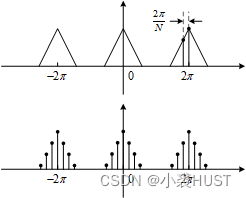
边栏推荐
- Solve the problem of "no input file specified" when ThinkPHP starts
- Interview questions for famous enterprises: Coins represent a given value
- What if win11 is missing a DLL file? Win11 system cannot find DLL file repair method
- 南京:全面启用商品房买卖电子合同
- Double pointer of linked list (fast and slow pointer, sequential pointer, head and tail pointer)
- Depth first DFS and breadth first BFS -- traversing adjacency tables
- 二叉树(二)——堆的代码实现
- The code generator has deoptimised the styling of xx/typescript. js as it exceeds the max of 500kb
- Google Maps case
- Oracle triggers
猜你喜欢

I closed the open source project alinesno cloud service

Business introduction of Zhengda international futures company
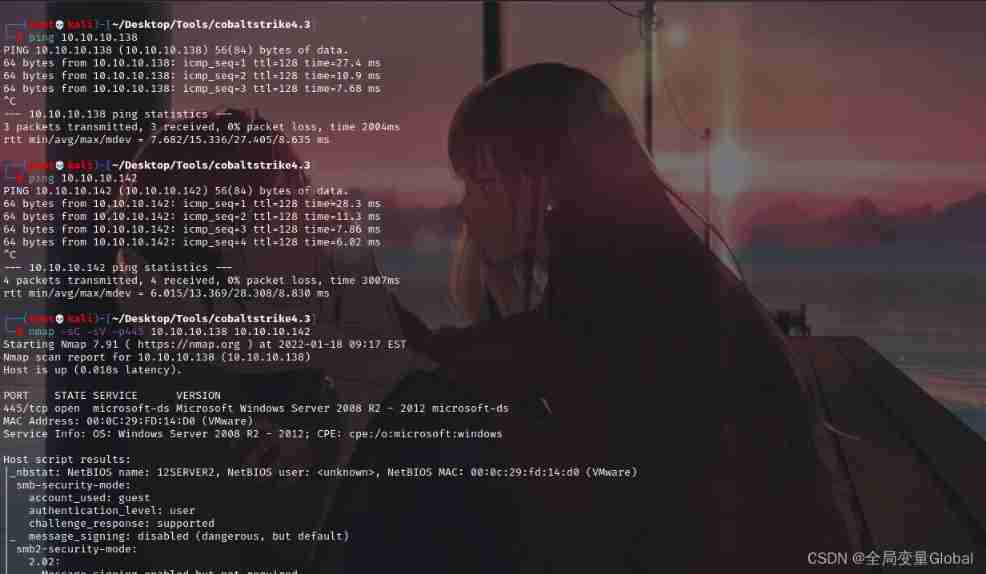
Cobaltstrike builds an intranet tunnel
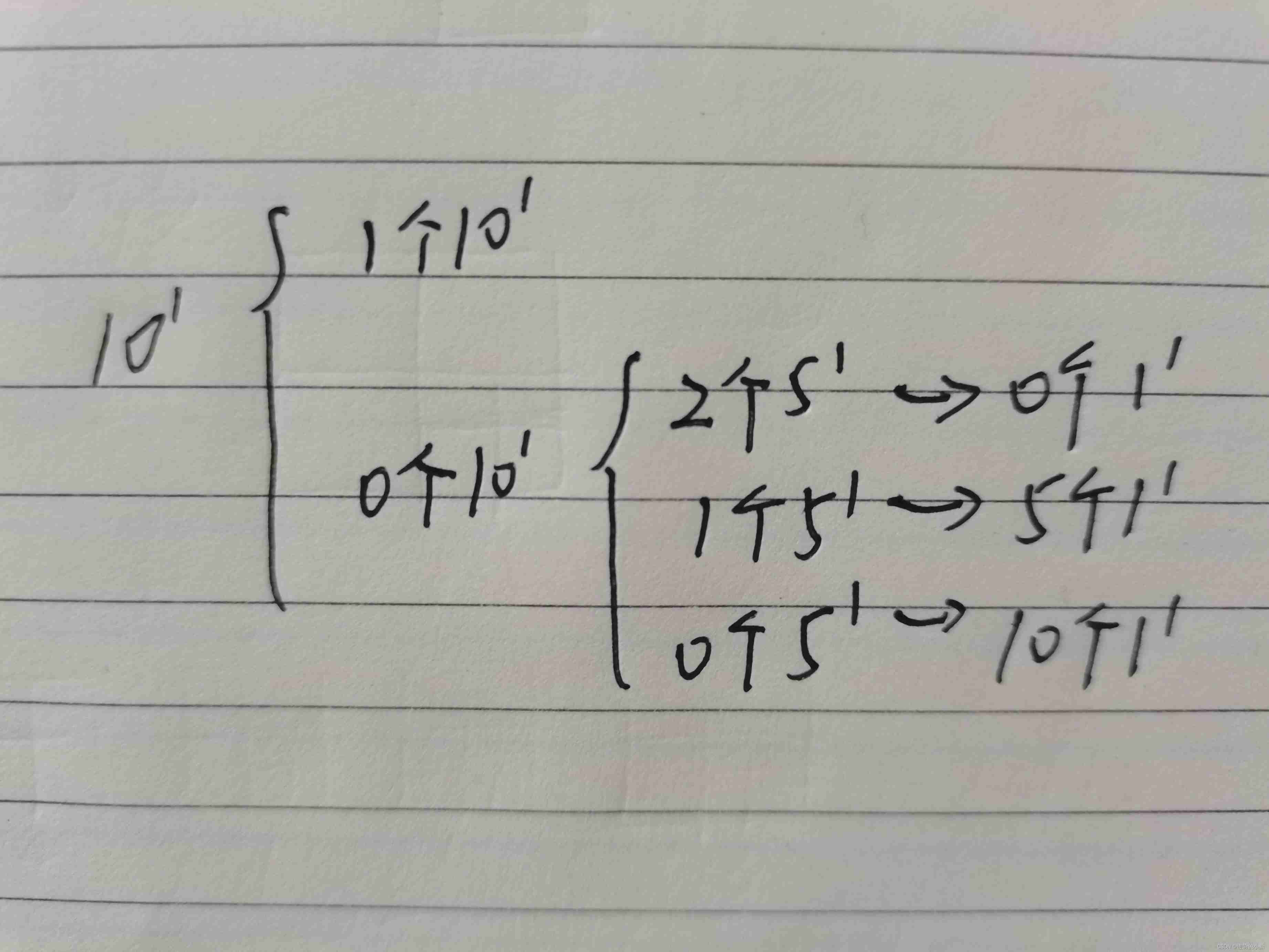
Interview questions for famous enterprises: Coins represent a given value

Qtquick3d real time reflection
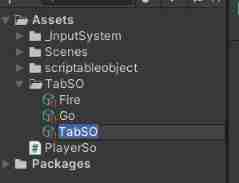
Usage Summary of scriptable object in unity
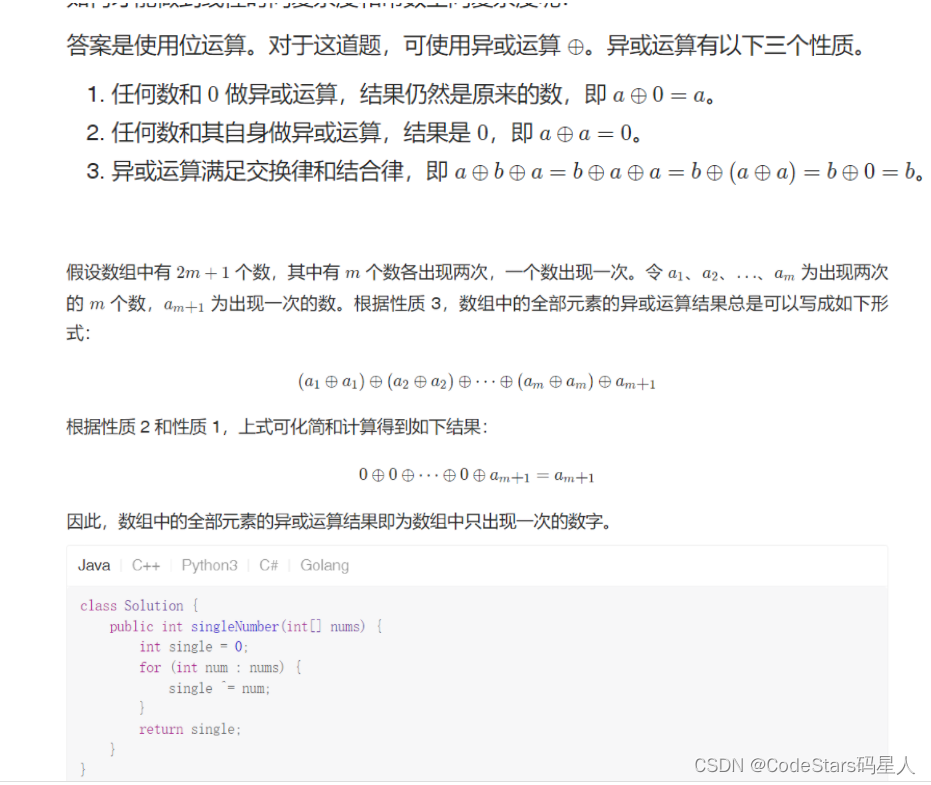
【无标题】

A substring with a length of three and different characters in the leetcode simple question

The statistics of leetcode simple question is the public string that has appeared once

Solutions for unexplained downtime of MySQL services
随机推荐
TCC of distributed solutions
Request preview display of binary data and Base64 format data
Kubernetes Administrator certification (CKA) exam notes (IV)
50. Pow(x, n). O(logN) Sol
鏈錶之雙指針(快慢指針,先後指針,首尾指針)
MySQL actual combat 45 lecture learning (I)
Three "factions" in the metauniverse
Metaverse ape received $3.5 million in seed round financing from negentropy capital
700. Search in a Binary Search Tree. Sol
二叉树(三)——堆排序优化、TOP K问题
Business introduction of Zhengda international futures company
Oracle hint understanding
Oracle triggers
[agc009e] eternal average - conclusion, DP
What about data leakage? " Watson k'7 moves to eliminate security threats
The new content of the text component can be added through the tag_ Config set foreground and background colors
513. Find the value in the lower left corner of the tree
70. Climbing Stairs. Sol
I closed the open source project alinesno cloud service
Pl/sql basic case